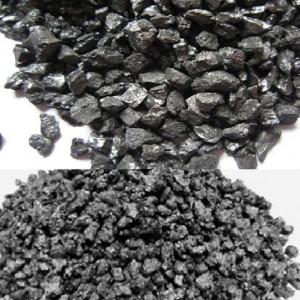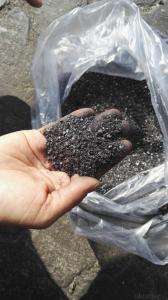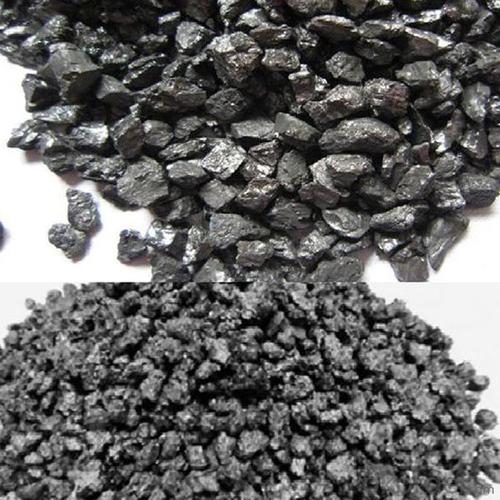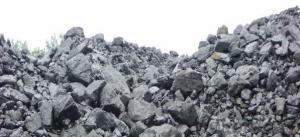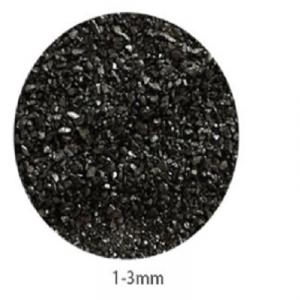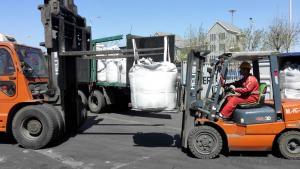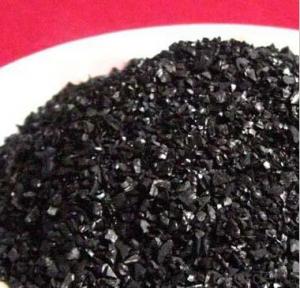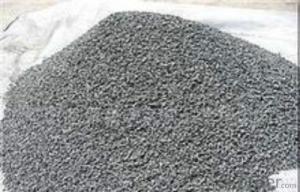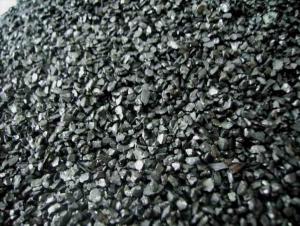Fixed carbon 90 Calcined anthracite as carbon additive
- Loading Port:
- Tianjin
- Payment Terms:
- TT /LC
- Min Order Qty:
- 20 m.t.
- Supply Capability:
- 10000 m.t./month
OKorder Service Pledge
OKorder Financial Service
You Might Also Like
Specification
Introduction
Carbon additive comes from delayed coke which extracted from oil refinery. Although carbon additive contains a little bit higher level of sulfur and nitrogen than pitch coke, the price advantage still makes it widely used during steel-making and founding as a kind of carbon additive/carburant. We provide carbon additive to steel plant to increase the carbon amount.
Features
Carbon Additive also called Calcined anthracite Coal, Gas Calcined Anthracite Coal, Carbon Raiser, Recarburizer, injection coke, charging coke and etc.
The main raw material of our Carbon Additive is Ningxia unique high quality Taixi anthracite, with characteristic of low ash and low sulfur. Carbon additive has two main usage, fuel and additive. When being used as the carbon additive of steel-smelting, and casting, the fixed carbon may achieve above 95%.
Best quality Taixi anthracite as raw materials through high temperature calcined at 1200-1250 ℃ for 24 hours by the DC electric calciner with results in eliminating the moisture and volatile matter from Anthracite efficiently, improving the density and the electric conductivity and strengthening the mechanical strength and anti-oxidation, It has good characteristics with low ash, low resistivity, low carbon and high density. It is the best material for high quality carbon products, it is used as carbon additive in steel industry or fuel.
We have the honor to be steady supplier of major steel company in Saudi Arabia, Philipines, Australia, Japan and other counties in the world
Specifications
PARAMETER UNIT GUARANTEE VALUE | |||||
F.C.% | 95MIN | 94MIN | 93MIN | 92MIN | 90MIN |
ASH % | 4MAX | 5MAX | 6MAX | 7MAX | 8MAX |
V.M.% | 1 MAX | 1MAX | 1.5MAX | 1.5MAX | 1.5MAX |
SULFUR % | 0.5MAX | 0.5MAX | 0.5MAX | 0.5MAX | 0.5MAX |
MOISTURE % | 0.5MAX | 0.5MAX | 0.5MAX | 0.5MAX | 0.5MAX |
Pictures
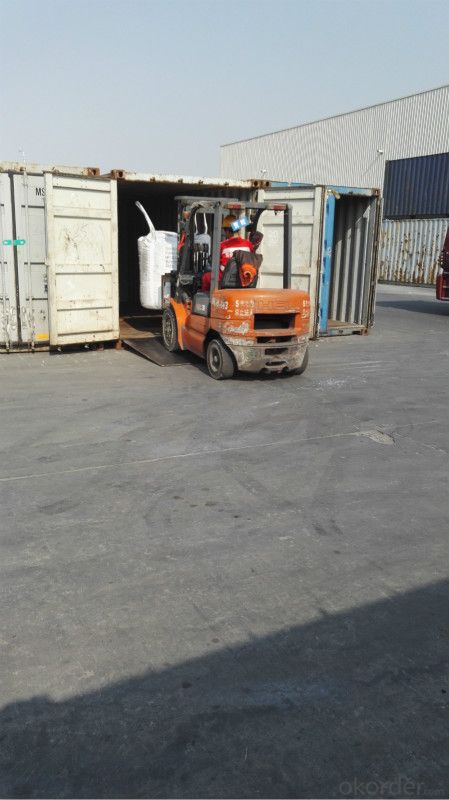
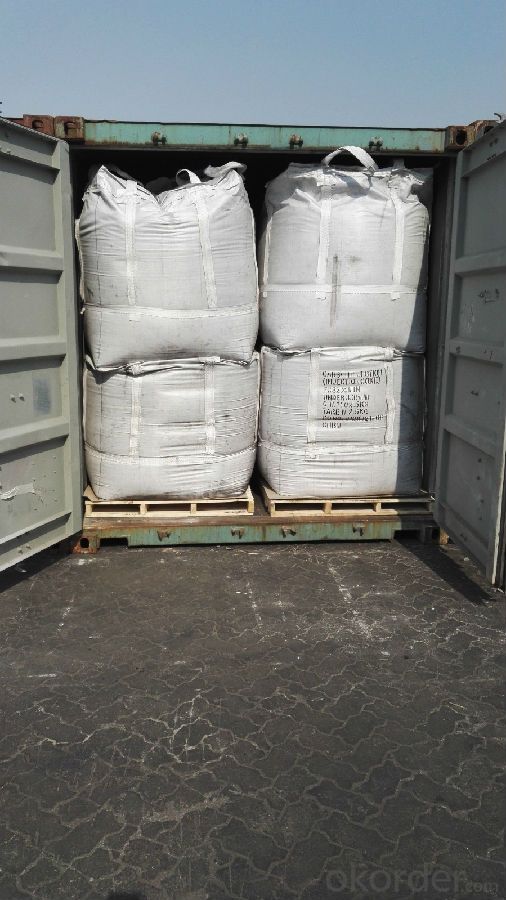
FAQ:
What is the packing?
In 25kg bag/ In jumbo bags without pallet/ Two jumbo bags with one pallet/ or as customers’ request
2. What is the production capacity?
10 thousand tons per month
3 What is payment term?
Irrevocable LC at sight/ 20% down payment by T/T and 80% against BL copy byT/T/ or to be discussed
4 What is the service?
We will send sample to the third party(CIQ, CCIC, SGS,BV or to be discussed) for checking, and present the test certificate and loading repot of shipment.
- Q: What are the effects of carbon emissions on the Earth's temperature?
- Carbon emissions, particularly carbon dioxide (CO2), have a significant impact on the Earth's temperature through the greenhouse effect. The greenhouse effect refers to the process by which certain gases in the Earth's atmosphere trap heat from the sun and prevent it from escaping back into space, thus warming the planet. When carbon emissions are released into the atmosphere, they act as a blanket, trapping more heat and exacerbating the greenhouse effect. This leads to an increase in global temperatures, commonly known as global warming. The primary source of carbon emissions is the burning of fossil fuels such as coal, oil, and natural gas for energy production, transportation, and industrial processes. The accumulation of carbon dioxide and other greenhouse gases in the atmosphere has resulted in a steady increase in global temperatures over the past century. This rise in temperature has numerous consequences for the Earth's climate system and ecosystems. One of the most immediate impacts of increased carbon emissions and global warming is the melting of polar ice caps and glaciers. As temperatures rise, ice melts at an accelerated rate, contributing to rising sea levels. This poses a significant threat to coastal areas, where increased flooding and erosion can occur, leading to the displacement of communities and loss of habitats for various species. Additionally, global warming disrupts weather patterns, leading to more frequent and intense extreme weather events. Heatwaves, droughts, hurricanes, and heavy rainfall events become more common, causing damage to infrastructure, agriculture, and human health. Changes in precipitation patterns also affect water availability and can lead to water scarcity in certain regions. The Earth's temperature directly influences ecosystems and biodiversity. Many species are highly sensitive to even small changes in temperature, which can disrupt their natural habitats, alter migration patterns, and impact reproductive cycles. These changes can ultimately lead to the extinction of certain species and disrupt entire ecosystems. Furthermore, the warming of the Earth's temperature can have cascading effects on various natural processes. For example, it can lead to the release of additional greenhouse gases from melting permafrost and the degradation of forests, further exacerbating global warming. In conclusion, the effects of carbon emissions on the Earth's temperature are profound and wide-ranging. Global warming caused by increased carbon dioxide levels leads to melting ice caps, rising sea levels, extreme weather events, disruptions to ecosystems, and potential loss of biodiversity. Addressing carbon emissions and working towards sustainable practices are crucial in mitigating these effects and ensuring a stable and habitable planet for future generations.
- Q: What is the density of carbon?
- The density of carbon is approximately 2.26 grams per cubic centimeter.
- Q: How does carbon impact the stability of desert ecosystems?
- Desert ecosystems can be influenced both positively and negatively by carbon. On the positive side, carbon is crucial for all living organisms and is a vital component of organic matter. It plays a critical role in essential processes like photosynthesis, respiration, and decomposition that are necessary for the survival and growth of plants and other organisms in deserts. During photosynthesis, plants take in carbon dioxide, a type of carbon, to produce glucose and oxygen, which are essential for their growth. This supports the stability of desert ecosystems by promoting primary productivity and the food web. However, the excessive release of carbon into the atmosphere, primarily caused by human activities such as burning fossil fuels and deforestation, has resulted in an increase in greenhouse gases, including carbon dioxide. This leads to global warming and climate change, which have detrimental effects on desert ecosystems. The rising temperatures can disrupt the delicate balance of desert ecosystems, impacting the distribution and abundance of plant and animal species. Some plants may struggle to adapt to the changing climate while others may benefit, resulting in changes to species composition and the potential loss of biodiversity. Additionally, elevated levels of carbon dioxide can impact water availability in desert ecosystems. Higher carbon dioxide levels can enhance water-use efficiency in plants, allowing them to conserve water. While this can be advantageous in water-limited environments such as deserts, it can also alter water dynamics, affecting the availability of water resources for other organisms in the ecosystem. To summarize, carbon is essential for the stability of desert ecosystems as it supports primary productivity and the functioning of food webs. However, the excessive release of carbon into the atmosphere contributes to climate change, negatively impacting desert ecosystems by altering species distribution, reducing biodiversity, and affecting water availability. It is crucial to mitigate carbon emissions and promote sustainable practices to ensure the long-term stability and resilience of desert ecosystems.
- Q: What are the impacts of carbon emissions on natural disasters?
- Carbon emissions contribute to the intensification and frequency of natural disasters. The release of greenhouse gases, such as carbon dioxide, traps heat in the atmosphere, leading to global warming and climate change. This warmer climate alters weather patterns, resulting in more frequent and severe events like hurricanes, droughts, wildfires, and floods. Additionally, the melting of polar ice caps due to increased temperatures raises sea levels, making coastal regions more vulnerable to storm surges and causing further devastation. Overall, carbon emissions exacerbate the impact of natural disasters, posing significant threats to human lives, ecosystems, and economies.
- Q: What is carbon offsetting in the automotive industry?
- Carbon offsetting in the automotive industry refers to the practice of compensating for the greenhouse gas emissions produced by vehicles. It involves investing in projects that reduce or remove carbon dioxide from the atmosphere, such as renewable energy projects, reforestation initiatives, or methane capture projects. By offsetting their emissions, automakers and individuals aim to neutralize or balance out the environmental impact of driving vehicles.
- Q: Joint carbide gas incident
- After a lapse of 25 years, a India District Court on 1984 Bhopal gas leak to be long in coming judgment, Union Carbide (India) Co., Ltd. 7 India nationals day was held for negligence causing death, they will face up to two years in prison. On the same day, hundreds of survivors, family members and environmentalists gathered around the courthouse to protest the court's decision that the perpetrators of the worst industrial disaster in twentieth Century were too light and too late. In 1969, Union Carbine Co established a Union Carbide in central India state of Bhopal Beijiao city (India) Co. Ltd., specializing in the production of aldicarb, carbaryl pesticide drops. The chemicals used in these products is called a methyl isocyanate poisonous gas. The early morning of December 3, 1984, this factory storage explosive liquid methyl isocyanate the steel tank, 45 tons of poison gas leak quickly, directly killed more than 1.5 people, allegedly have caused more than 550 thousand people died and chemical poisoning related lung cancer, renal failure and liver disease.
- Q: Speak in detail! I am ~ carbon Roast Lamb Leg lamb chops lamb barbecue ah ~ ~ how to do with practice video line! And how do you bake the oven?
- Step 1: the leg with a knife cut, and then put into the seasoning pickled, according to the guests taste add salt, pepper, fennel, pepper and so on, this time can not add cumin. These ingredients should be fully blended and then applied to the surface of the meat. Then sealed with a sealed instrument to allow the meat to be fully salted and flavored, preferably 3 hours.
- Q: How does carbon contribute to the color of gemstones?
- Gemstone color is influenced by carbon, a vital element. Carbon's presence in a gemstone's crystal lattice structure allows it to absorb specific light wavelengths and reflect others, resulting in its distinct color. The arrangement of carbon atoms within the gemstone's structure can excite electrons, leading to the absorption of certain colors of light. This absorption process determines the gemstone's color, as the remaining wavelengths are reflected back to our eyes. For instance, diamonds can exhibit color variations, ranging from colorless to yellow or even fancy shades like blue or pink, due to the presence of nitrogen impurities. Similarly, in gemstones like rubies and sapphires, traces of carbon produce a spectrum of colors, spanning from red to blue, depending on the concentration and arrangement of these carbon impurities. Thus, carbon plays a vital role in the color and visual appeal of diverse gemstones.
- Q: 14 is the upper left corner of the mark, please answer a bit more detailed, thank you!
- First hit C14, then select 14, open the format, font, click the "effect" in "superscript" is fine.
- Q: What are the uses of carbon black?
- Carbon black has a wide range of uses across various industries due to its unique properties. One of the primary uses of carbon black is as a reinforcing filler in rubber materials. It improves the strength, durability, and resistance to wear and tear of rubber products, making them suitable for applications such as tires, conveyor belts, gaskets, hoses, and shoe soles. Carbon black is also used as a pigment in inks, coatings, and dyes. Its high tinting strength and ability to absorb ultraviolet light make it an excellent choice for coloring plastics, paints, and printing inks. Additionally, carbon black is used in toners for photocopiers and laser printers, providing the dark color required for high-quality printing. Furthermore, carbon black finds applications in the manufacturing of electrodes for batteries and fuel cells. Its electrical conductivity and high surface area make it an ideal material for enhancing the performance and efficiency of energy storage devices. Carbon black is also used in the production of carbon brushes, which are crucial components in electric motors and generators. In the construction industry, carbon black is utilized as a filler in concrete and asphalt to enhance their strength and durability. It improves the resistance to weathering, reduces cracking, and increases the lifespan of these materials. Additionally, carbon black is employed in the production of conductive polymers used for static dissipation and electromagnetic shielding in various construction materials. In summary, the uses of carbon black are diverse and span across multiple industries. From reinforcing rubber products to coloring inks and coatings, enhancing energy storage devices, and improving the strength of construction materials, carbon black plays a vital role in enhancing the performance and durability of various products.
Send your message to us
Fixed carbon 90 Calcined anthracite as carbon additive
- Loading Port:
- Tianjin
- Payment Terms:
- TT /LC
- Min Order Qty:
- 20 m.t.
- Supply Capability:
- 10000 m.t./month
OKorder Service Pledge
OKorder Financial Service
Similar products
Hot products
Hot Searches
Related keywords
